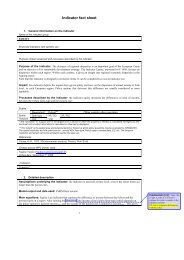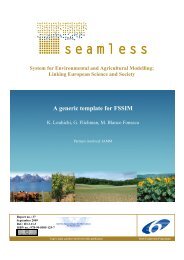Farming Systems Design 2007 - International Environmental ...
Farming Systems Design 2007 - International Environmental ...
Farming Systems Design 2007 - International Environmental ...
You also want an ePaper? Increase the reach of your titles
YUMPU automatically turns print PDFs into web optimized ePapers that Google loves.
<strong>Farming</strong> <strong>Systems</strong> <strong>Design</strong> <strong>2007</strong><br />
Field-farm scale design and improvement<br />
Tab. 2 - Normalized impact values in Cynara crop<br />
Cynara cardunculus<br />
Impact categories First two year average 4 th year<br />
I 75 I 25 N 100 N 50 no input<br />
Energy resources use 115.1 91.5 118.5 88.1 5.8<br />
Global warming -3538 -2750 -3064 3225 -946<br />
Ozone depletion 788.5 521.8 808.3 502.0 1.9<br />
Atm. acidification 236.1 236.1 282.7 189.5 5.2<br />
Water eutrophic. 534.9 455.3 589.3 400.9 -17.9<br />
Summer smog 35.4 25.3 32.5 28.1 2.4<br />
Human toss. vs. air 35.6 25.7 33.1 28.1 2.2<br />
Global warming<br />
depends on yields,<br />
being lower in Arundo<br />
compared to Miscanthus<br />
and Cynara; negative<br />
values indicate the CO 2<br />
balance results<br />
favourable for the<br />
environment. Ozone<br />
depletion, atmosphere<br />
acidification and water eutrophication are strictly linked to fertilizers application, and so they<br />
resulted low in no input treatment in all studied crops.<br />
Summer smog and human toxicity vs. air, in the average, resulted equal to 37.8 and 37.0,<br />
respectively (tab. 1 and 2).<br />
Tab. 3 – Net CO 2 sequestred by crops (%)<br />
In table 3 the<br />
Net CO 2 sequestred by crops (%)<br />
percentage of net CO 2<br />
2 nd and 3 rd years average Fourth year<br />
sequestred by crops is<br />
I 75 N 100 I 75 N 50 I 25 N 100 I 25 N 50 no input<br />
shown: low differences<br />
Arundo donax 96.0 97.1 96.2 97.4 99.7<br />
are recorded within<br />
Miscanthus x giganteus 93.1 95.2 92.7 95.5 99.7<br />
Cynara cardunculus 93.8 96.1 94.2 93.5 99.4<br />
studied treatments and<br />
within crops: in the<br />
second and third years the percentage was higher in Arundo (96.7%), followed by Cynara (95.0%)<br />
and Miscanthus (94.1%). In the fourth year, 99.6% of net CO 2 sequestred by crops in the average.<br />
In table 4 percentage of agricultural phase in the respect to biofuel chain are indicated: the lowest<br />
values are obtained in low input treatment for each crop. As far as water and fertilizer treatments<br />
are concerned, in Miscanthus higher values than the other crops were obtained. In particular, its<br />
crop management affected energy resource use (52.7%), ozone depletion (52.3%), global warming<br />
(49.7%) and water eutrophication (48.5%).<br />
Tab. 4 - Percentage of agricultural phase respect to biofuel chain (%)<br />
Arundo Miscanthus Cynara<br />
Impact categories treatment no input treatment no input treatment no input<br />
(average)<br />
(average)<br />
(average)<br />
Energy resources use 43.7 5.2 52.7 6.7 35.9 9.1<br />
Global warming 38.6 2.7 49.7 3.4 33.0 5.4<br />
Ozone depletion 37.5 0.3 52.3 0.4 36.6 0.6<br />
Atm. acidification 17.5 0.6 30.5 0.8 15.1 1.3<br />
Water eutrophic. 32.2 48.5 29.0<br />
Summer smog 11.4 0.8 20.0 1.1 5.6 1.7<br />
Human toss. vs. air 3.4 0.2 7.4 0.3 1.6 0.4<br />
Conclusions<br />
Under no input condition, crop management may lead environmental benefits. Irrigation and<br />
fertilization strongly affected the environmental impacts. In general, more than 90% of CO 2<br />
sequestred by crops is available for further uses (heat, electricity, bio-ethanol).<br />
References<br />
Brentrup F. et al. 2001 Application of the Life Cycle Assessment methodology to agricultural<br />
production: an example of sugar beet production with different forms of nitrogen fertilizers.<br />
European J. od Agronomy, 14: 221-233.<br />
Cosentino S. et al. 2005. Confronto tra impatti ambientali di biocombustibili fossili per mezzo della<br />
“Life Cycle Assessment” (LCA). Agroindustria, 4, 1: 109-128.<br />
Reinhardt G. et al. 2000 Final Report. Bioenergy for Europe: which ones fit best? – A comparative<br />
analysis for the community. Heidelberg. pp.178.<br />
- 26 -




